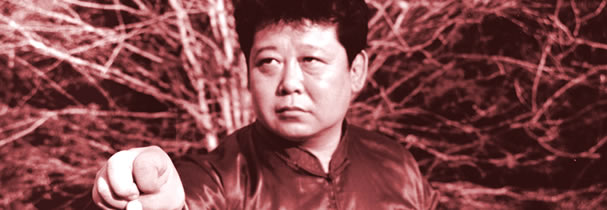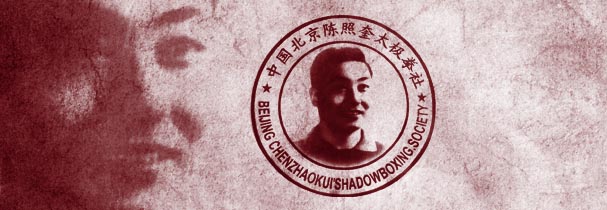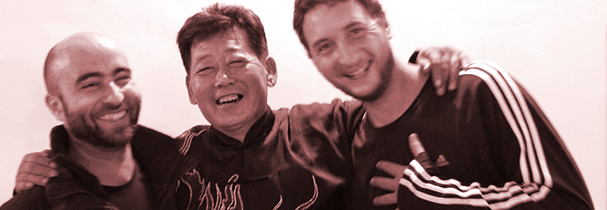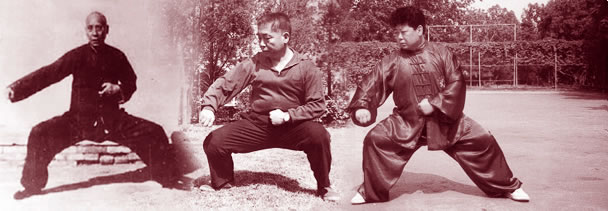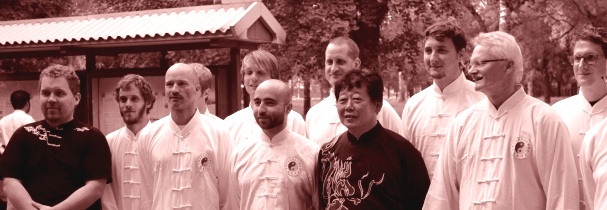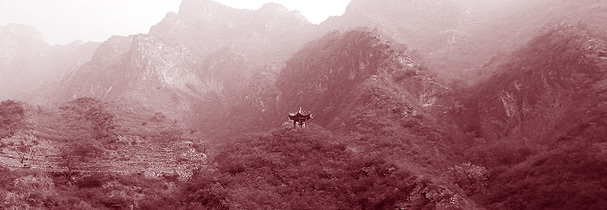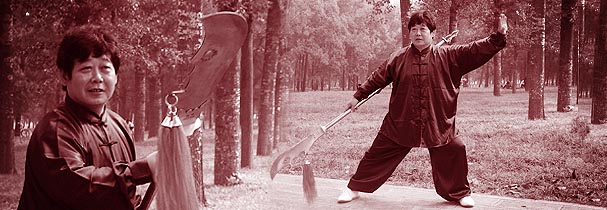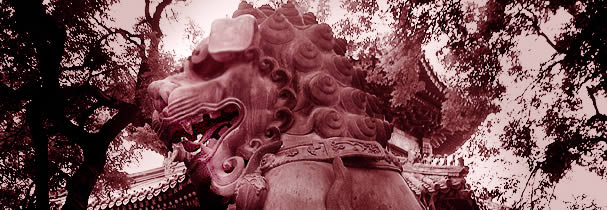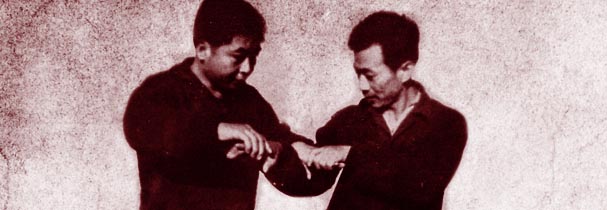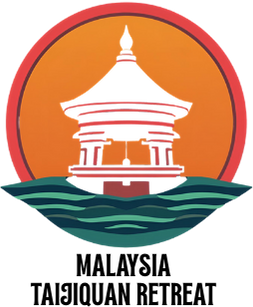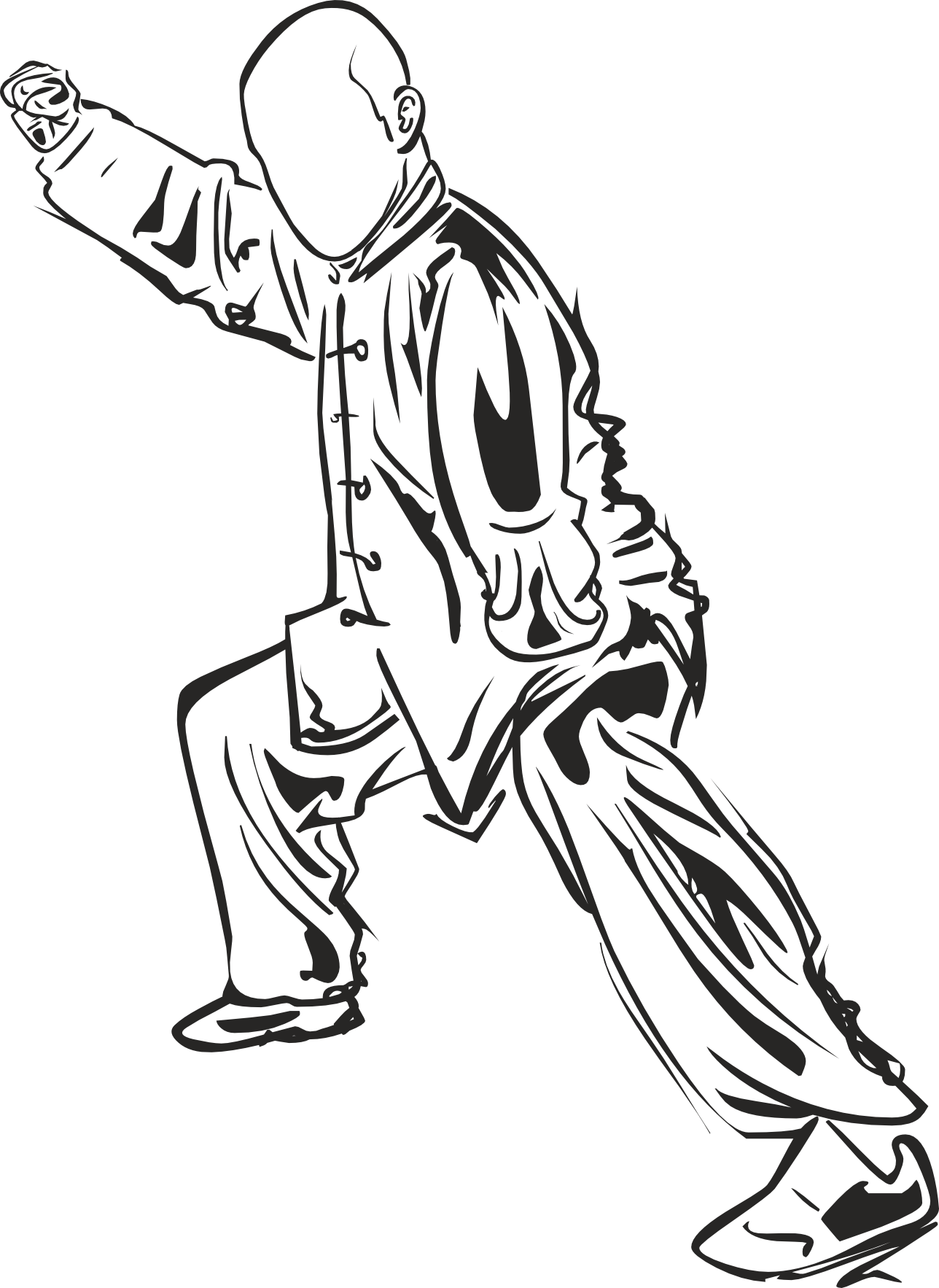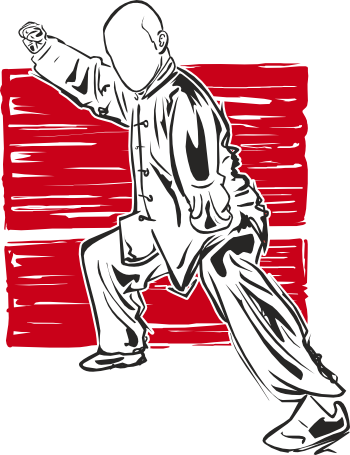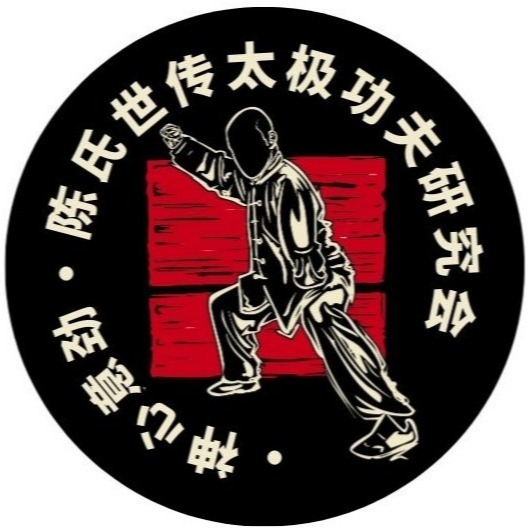Traditional Chen-Style Taijiquan
 We represent a modern, precise and powerful Taijiquan (Tai Chi Chuan) in direct Chinese tradition! Our family style is detailed and not easy to learn, which is why it is often called Taiji Gongfu. The training is substantial and requires diligence and perseverance. However, the impact on body and mind are considerable for everyone with an assiduous practice. The vigorous movements flow fast or slow in constant interplay. The system is composed of basics, hand and weapon forms and partner training. Our Taijiquan can be practiced by both dedicated amateurs and committed professionals. We emphasize the practicality and applicability of our kungfu style, the martial as well as the health benefits, transparency in our teaching, and a self-responsible learning, an equal student-teacher relationship, as well as personal development by cultivating concentration, stamina and sensitivity. Mutual respect, honesty and fun are therefore as much part of our training as are profound, detailed and modern contents!
We represent a modern, precise and powerful Taijiquan (Tai Chi Chuan) in direct Chinese tradition! Our family style is detailed and not easy to learn, which is why it is often called Taiji Gongfu. The training is substantial and requires diligence and perseverance. However, the impact on body and mind are considerable for everyone with an assiduous practice. The vigorous movements flow fast or slow in constant interplay. The system is composed of basics, hand and weapon forms and partner training. Our Taijiquan can be practiced by both dedicated amateurs and committed professionals. We emphasize the practicality and applicability of our kungfu style, the martial as well as the health benefits, transparency in our teaching, and a self-responsible learning, an equal student-teacher relationship, as well as personal development by cultivating concentration, stamina and sensitivity. Mutual respect, honesty and fun are therefore as much part of our training as are profound, detailed and modern contents!
Chen Fake
(17th generation Chen family)
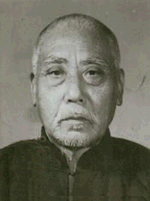 Chen Fake (Ch. 陈 发 科, 1887-1957), who was also called Chen Fusheng, is regarded as an outstanding representative of Chen-style Taijiquan in the 20th century. Even today, this representative of the 17th family generation was called "the number one of Taijiquan”. He was also said to embody the Wude, the unit of martial arts and virtue. According to Chen Yu Chen Fake perfected his gongfu frame in his last years and taught this only to his son Chen Zhaokui. Our 83 form goes back to this long-standing tradition, allowing us a glimpse into the martial arts practice of the previous centuries. Thanks to his high skills Chen Fake made the original Taijiquan of his family known in Beijing. Among his pupils were so prominent figures such as Chen Zhaokui, Chen Zhaoxu, Feng Zhiqiang, Gu Liuxin, Hong Junsheng, Lei Muni, Tian Xiuchen etc., all of which later became famous for their own developments and skills in Taijiquan.
Chen Fake (Ch. 陈 发 科, 1887-1957), who was also called Chen Fusheng, is regarded as an outstanding representative of Chen-style Taijiquan in the 20th century. Even today, this representative of the 17th family generation was called "the number one of Taijiquan”. He was also said to embody the Wude, the unit of martial arts and virtue. According to Chen Yu Chen Fake perfected his gongfu frame in his last years and taught this only to his son Chen Zhaokui. Our 83 form goes back to this long-standing tradition, allowing us a glimpse into the martial arts practice of the previous centuries. Thanks to his high skills Chen Fake made the original Taijiquan of his family known in Beijing. Among his pupils were so prominent figures such as Chen Zhaokui, Chen Zhaoxu, Feng Zhiqiang, Gu Liuxin, Hong Junsheng, Lei Muni, Tian Xiuchen etc., all of which later became famous for their own developments and skills in Taijiquan.
Chen Zhaokui
(18th generation Chen family)
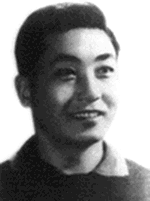 Chen Zhaokui (Ch.陈照奎, 1928-1981) learned his father’s Taijiquan and was the most important representative of the large frame in the 18th generation of the Chen family. In 1932 he followed his father to Beijing at the age of four and later taught there, but also in other parts of China. Especially during the difficult political and social upheavals of the People's Republic in the sixties and seventies he contributed much to the teaching of the next generation. He stressed that his form had never been passed down in such a detailed way outside the family since Chen Changxing. His son Chen Yu accompanied him on all trips and learned intensively with him until his death. Chen Zhaokui returned to his birthplace Chenjiagou three times in total to teach: 1973, 1974 and 1978. At the invitation of the village elders he trained the next generation in Taijiquan. In the village they did not know the method which was passed down by Chen Fake and therefore called it "the new frame". Although his forms are still being practiced in Chenjiagou today, their inherent method how to teach and train them has been mostly forgotten or changed in the village. Among Chen Zhaokuis student were many personalities which are internationally known today. In Chenjiagou Chen Xiaowang, Chen Zhenglei, Zhu Tiancai, Wang Xian, Chen Dewang, Chen Suying, Chen Guizhen and Chen Chunai learned from him. In Zhengzhou, there were among others Zhang Maozhen, Zhang Qilin, Zhang Zhijun and Hai Yuqing, in Shanghai Wan Wende, Du Wencai, Zhang Caigen and more. Chen Zhaokui paid great attention to the fighting aspects of Taijiquan.
Chen Zhaokui (Ch.陈照奎, 1928-1981) learned his father’s Taijiquan and was the most important representative of the large frame in the 18th generation of the Chen family. In 1932 he followed his father to Beijing at the age of four and later taught there, but also in other parts of China. Especially during the difficult political and social upheavals of the People's Republic in the sixties and seventies he contributed much to the teaching of the next generation. He stressed that his form had never been passed down in such a detailed way outside the family since Chen Changxing. His son Chen Yu accompanied him on all trips and learned intensively with him until his death. Chen Zhaokui returned to his birthplace Chenjiagou three times in total to teach: 1973, 1974 and 1978. At the invitation of the village elders he trained the next generation in Taijiquan. In the village they did not know the method which was passed down by Chen Fake and therefore called it "the new frame". Although his forms are still being practiced in Chenjiagou today, their inherent method how to teach and train them has been mostly forgotten or changed in the village. Among Chen Zhaokuis student were many personalities which are internationally known today. In Chenjiagou Chen Xiaowang, Chen Zhenglei, Zhu Tiancai, Wang Xian, Chen Dewang, Chen Suying, Chen Guizhen and Chen Chunai learned from him. In Zhengzhou, there were among others Zhang Maozhen, Zhang Qilin, Zhang Zhijun and Hai Yuqing, in Shanghai Wan Wende, Du Wencai, Zhang Caigen and more. Chen Zhaokui paid great attention to the fighting aspects of Taijiquan.
Chen Yu
(19th generation Chen family)

Chen Yu (Chin. 陈瑜, born 1962) was born in Chenjiagou in Henan Province and is a representative of the 19th generation of the Chen family. He teaches Taijiquan in the old family tradition and places extraordinary emphasis on the exact execution of forms, conscientious training and both combative and health benefits. In Chinese martial arts circles, he is highly regarded for his impressive skills and his very special workmanship in Chen-style Taijiquan. In addition to a variety of honorary positions Chen Yu is the president of the Chen Taijiquan Zhaokui Society. He is the only child of Chen Zhaokui and grandson of the legendary Chen Fake, who introduced the Taijiquan of the founding family to Beijing. He began to assist his father at a very young age in teaching. His powerful forms and partner exercises are finely elaborated and with intensive training allow for a rapid progress. His method is exceptional and requires perseverance, which is why it is often given the name "Taiji gongfu".
Chen-Style Taijiquan Network:
Nabil Ranné
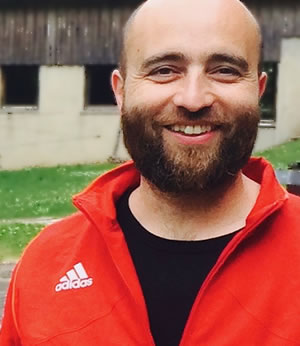
Nabil Ranné, born in 1975, teaches Taijiquan (Tai Chi Chuan) as a direct disciple (dizi) of Chen Yu. He wrote his dissertation in sports sciences on the sociocultural development of the art, published several articles on the topic of Taijiquan and is a co-founder of the Chen-Style Taijiquan Network Germany (CTND). Nabil learnt Chen Yu’s unique method in a small family setting. The method is commonly regarded to be extremely accurate, compact and strong. Consequently he spent some years in intensive training mainly in China and Australia. Meanwhile, Nabil teaches this rich martial art in Germany and abroad.
Konstantin Berberich

Konstantin Berberich, born in 1982, is a co-founder of the Chen-Style Taijiquan Network Germany (CTND), 20th generation lineage holder and director of the Stuttgart branch of the CTND. He started to intensively learn Asian and Filipino martial arts in his youth. From his passion he started to specialize on the practical Chen Yu Taijiquan with its unique movement methodology. Consequently Konstantin became Chen Yu's official student. He teaches in his own school in Stuttgart and at several other locations in Germany.
CHEN-STYLE TAIJIQUAN YILU (FIRST ROAD) FORM NAMES
1. 預備式 Yu bei shi
Preparation
2. 起式 Qi shì
Commencing move
3. 金刚捣碓 Jingang dao dui
Buddha’s warrior pounds mortar
4. 懒扎衣 Lan zha yi
Lazily tying coat
5. 六封四闭 Liu feng si bi
Six times sealed, four times closed
6. 单鞭 Dan bian
Single whip
7. 第二个金刚捣碓 Di er ge jingang dao dui
Buddha’s warrior pounds mortar
8. 白鹤亮翅 Bai he liang chi
White crane reveals its wings
9. 斜行 Xie xing
Oblique walking
10. 初收 Chu shou
First gathering
11. 前膛拗步 Qian tang ao bu
Wade forward and twist step
12. 第二个斜行 Di er ge xie xing
Second oblique walking
13. 再收 Zai shou
Second gathering
14. 第二前膛拗步 Di er ge qian tang ao bu
Wade forward and twist step, second time
15. 掩手肱捶 Yan shou gong chui
Cover with your hand and strike with your upper arm (hidden punch)
16. 十字手 Shizi shou
Cross hands
17. 第三个金刚捣碓 Di san ge jingang dao dui
Buddha’s warrior pounds mortar
18. 庇身捶 (背折靠) Bi shen chui (Bei zhe kao)
Cover the body and strike (the back folds and strikes)
19. 青龙出水 Qing long chu shui
The blue-green dragon shoots out of the water
20. 双推掌 Shuang tui zhang
Double palm push
21. 三换掌 San huan zhang
Three palm changes
22. 肘底捶 Zhou di chui
Punch under the elbow
23. 倒卷肱 Dao juan gong
Turn around and roll in upper arms
24. 退步压肘 Tui bu ya zhou
Step back and press down with your elbow
25. 中盘 Zhong pan
Middle winding
26. 白鹤亮翅 Bai he liang chi
White crane reveals its wings
27. 斜行拗步 Xie xing ao bu
Oblique walking
28. 闪通背 Shan tong bei
Dodge through the back
29. 掩手肱捶 Yan shou gong chui
Cover with your hand and strike with your upper arm
30. 大六封四闭 Da liu feng si bi
Six times sealed, four times closed (big)
31. 单鞭 Dan bian
Single whip
32. 运手 Yun shou
Circling hands
33. 高探马 Gao tanma
Mounted scout
34. 右擦脚 You ca jiao
Wipe the right foot
35. 左擦脚 Zuo ca jiao
Wipe the left foot
36. 转身左蹬脚 Zhuan shen zuo deng jiao
Turn and kick with the left heel
37. 前膛拗步 Qian tang ao bu
Wade forward and twist step
38. 击地锤 Ji di chui
Punch down
39. 翻身二起脚 (神仙一把抓) Fan shen er qi jiao (Shenxian yi ba zhua )
Turn body and kick with both feet (the immortal takes hold)
40. 护心锤 Hu xin chui
Protect the heart and strike
41. 旋风脚 Xuan feng jiao
Tornado kick
42. 右蹬一根 You deng yi gen
Right heel kick
43. 海底翻花 Hai di fan hua
Turn the flower on the seabed
44. 掩手肱锤 Yan shou gong chui
Cover with your hand and strike with your upper arm
45. 小擒打 Xiao qin da
Small capture and punch
46. 抱头推山 (金丝缠腕) Bao tou tui shan (Jin si chan wan)
Hold head and push mountain (wrap the golden silk around the wrist)
47. 三换掌 San huan zhang
Three palm changes
48. 六封四闭 Liu feng si bi
Six times sealed, four times closed
49. 单鞭 Dan bian
Single whip
50. 前招 Qian zhao
Forward maneuver (lure forward)
51. 后招 Hou zhao
Backward maneuver (lure backward)
52. 右野马分鬃 You yema fen zong
Part the wild horse’s mane right
53. 左野马分鬃 Zuo yema fen zong
Part the wild horse’s mane left
54. 大六封四闭 Da liu feng si bi
Six times sealed, four times closed
55. 单鞭 Dan bian
Single whip
56. 双震脚 Shuang zhen jiao
Stamp with both feet
57. 玉女穿梭 Yunü chuansuo
The jade maiden works the shuttle
58. 懒扎衣 Lan zha yi
Lazily tying coat
59. 六封四闭 Liu feng si bi
Six times sealed, four times closed
60. 单鞭 Dan bian
Single whip
61. 运手 Yun shou
Circling hands
62. 双摆莲 Shuang bai lian
Double lotus kick
63. 跌叉 Die cha
Fall and split
64. 右金鸡独立 You jinji duli
The golden rooster stands on one leg, right
65. 左金鸡独立 Zuo jinji duli
The golden rooster stands on one leg, left
66. 倒卷肱 Dao juan gong
Turn around and roll in your upper arms
67. 退步压肘 Tui bu ya zhou
Step back and press down with your elbow
68. 中盘 Zhong pan
Middle winding
69. 白鹤亮翅 Bai he liang chi
White crane reveals its wings
70. 斜行拗步 Xie xing ao bu
Oblique walking
71. 闪通背 Shan tong bei
Dodge through the back
72. 掩手肱锤 Yan shou gong chui
Cover with your hand and strike with your upper arm
73. 大六封四闭 Da liu feng si bi
Six times sealed, four times closed (big)
74. 单鞭 Dan bian
Single whip
75. 运手 Yun shou
Circling hands
76. 高探马 Gao tan ma
Mounted scout
77. 十字单摆莲 Shizi dan bai lian
Cross hands, single lotus kick
78. 海底翻花 Hai di fan hua
Turn the flower on the seabed
79. 指裆锤 Zhi dang chui
Striking the crotch
80. 白猿献果 Bai yuan xian guo
White ape presents fruit
81. 小六封四闭 Xiao liu feng si bi
Six times sealed, four times closed (small)
82. 单鞭 Dan bian
Single whip
83. 雀地龙 Que di long
The dragon sinks to the ground
84. 上步骑麟 (上步七星) Shang bu qilin (Shang bu qi xing)
Step forward and ride the unicorn (seven stars posture)
85. 下步跨虎 Xia bu kua hu
Step back and mount the tiger
86. 转身双摆莲 Zhuan shen shuang bai lian
Turn around, double lotus kick
87. 当头炮 Dang tou pao
Hitting the head
88. 金刚捣碓 Jingang dao dui
Buddha’s warrior pounds mortar
89. 收势 Shou shì
Finish form
© 2019 Daniel Barth, Peter Loughlin and Chen-Stil Taijiquan Netzwerk Deutschland
